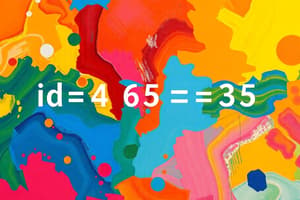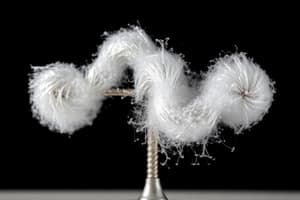Podcast
Questions and Answers
The total pressure exerted by a gas mixture is equal to the sum of the partial pressures exerted by each component of the mixture.
The total pressure exerted by a gas mixture is equal to the sum of the partial pressures exerted by each component of the mixture.
True (A)
At STP, 1 mole of any gas occupies a volume of 22.4 liters.
At STP, 1 mole of any gas occupies a volume of 22.4 liters.
True (A)
Avogadro's Law states that equal volumes of gases at the same temperature and pressure contain the same number of molecules.
Avogadro's Law states that equal volumes of gases at the same temperature and pressure contain the same number of molecules.
True (A)
The molecular weight of cyclopropane is 42.0 g/mol.
The molecular weight of cyclopropane is 42.0 g/mol.
According to the Ideal Gas Equation, PV = nRT, where P is pressure, V is volume, n is number of moles, R is the ideal gas constant, and T is temperature in Kelvin.
According to the Ideal Gas Equation, PV = nRT, where P is pressure, V is volume, n is number of moles, R is the ideal gas constant, and T is temperature in Kelvin.
An increase in temperature will lead to an increase in the volume occupied by a gas, assuming other factors remain constant.
An increase in temperature will lead to an increase in the volume occupied by a gas, assuming other factors remain constant.
A decrease in pressure will result in a decrease in the volume occupied by a gas, if all other factors are held constant.
A decrease in pressure will result in a decrease in the volume occupied by a gas, if all other factors are held constant.
The empirical formula of cyclopropane is CH2.
The empirical formula of cyclopropane is CH2.
The density of NH3 at 100°C and 1.15 atm is 0.638 g/L.
The density of NH3 at 100°C and 1.15 atm is 0.638 g/L.
In Example 5, the volume occupied by 10.0g of CO2 at 27°C and 2.0 atm is 2.8 liters.
In Example 5, the volume occupied by 10.0g of CO2 at 27°C and 2.0 atm is 2.8 liters.
Flashcards are hidden until you start studying




